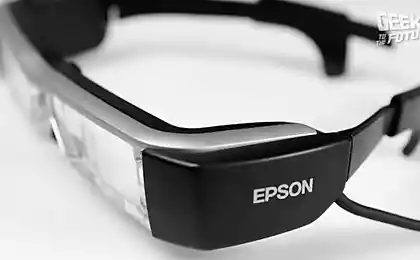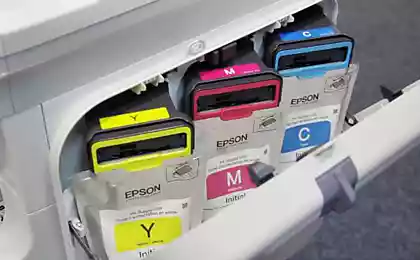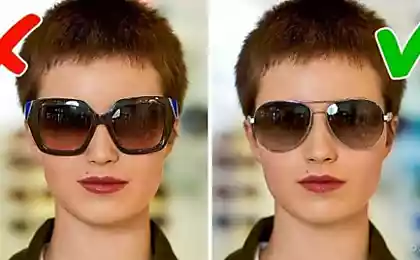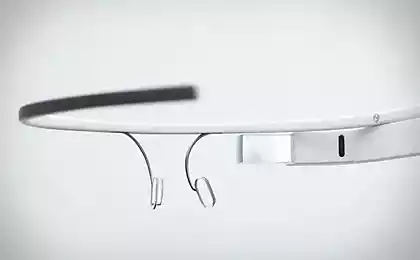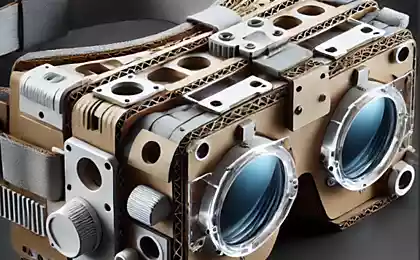1534
Review of augmented reality glasses Epson Moverio BT-200

The explosion of the popularity of augmented reality devices is still ahead, and the more interest is caused by the few available gadgets. Especially those with an unusual approach or implementation. In particular, the Epson Moverio BT-200, the second model of augmented reality glasses from the Japanese manufacturer. And today we offer you an overview of this curious device.
We have not in vain started talking about the non-standard approach: glasses are connected to an external system unit running Android 4.0.4 and having a touchpad. They have two semi-transparent mini-displays with a total resolution of 960x540, as well as a camera that allows you to use augmented reality scenarios. In addition, the manufacturer launched a store with eyewear apps, Moverio Apps Market.
The device turned out to be universal. In addition to the aforementioned augmented reality, glasses are well suited for gaming and watching videos. For example, BT-200 is already used in medicine, superimposing a blood vessel circuit on the human body, making it easier for nurses to draw blood from veins and arteries.
The main characteristics of the display 2 translucent LCD display (polysilicon active matrix) with a diagonal of 0.42 inches, 16:9 format, total resolution 960x540 Subjective size of the perceived image 40 inches from a distance of 2.5 m, 320 inches from 20 m Update 60 Hz Android 4.0.4 Pre-installed applications Moverio Air, Moverio Apps Market, Moverio Mirror, SEViewer Camera Resolution VGA Wiretility-Fi communication IEEE 802 GBUPRO, Digital Dolby + USB2 memory support for 340 GBUPRO, 300+GM memory memory (DOMBYPRO, 3000000000000000000000000000000000000000000000000000000000000000000000000000000000000000000000000000000000000000000000000000000000000000000000000000000000000000000000000000000000000000000
Externally, the system unit looks like a hybrid of a small smartphone and a solar battery. It contains a processor, memory, connectors, wireless communication modules. The system wire connects to glasses, which still look more like a specialized tool than a fashion accessory.
In the folded state, the dimensions of the glasses are 170x185x32 mm, the weight is 88 grams. Quite weighty, but ergonomics are at a height, so they can be worn for a long time without fatigue. The design of the BT-200 allows you to wear over ordinary glasses, so you do not have to make a choice. Removable rubber nozzles on the arches allow you to adjust the landing of glasses depending on the hairstyle and the structure of the user's head. If necessary, you can attach a darkening nozzle outside.
The glasses come in a bulky case, so you can not be afraid for their safety when transported in luggage or hand luggage. The assembly of glasses is high-quality, without cracks, backlashes and creaks.
On the right is the lens of the built-in camera. The wire is connected next to the left arc hinge. On the wire there is an intermediate block with a pinch, equipped with a connector for connecting headphones (also come in the kit). The main problem is the inconsistency of connecting the wire with glasses. With careless or very active wearing, there is a risk of rubbing or breaking.
Let’s take a closer look at the system unit. Under a large “screen” touchpad are three buttons responsible for calling the context menu, transitioning to the main screen and returning back. At the top, above the logo is an LED status indicator.
Dimensions of the system unit - 120x55x19 mm, weight - 124 grams. Pretty fat and not very comfortable in the hand.
On the upper end of the system unit there is a slider on / off the device, which is also responsible for blocking buttons. If he is moved and released, he returns to the central position. On the lower end is a proprietary connector for connection with glasses. On the right end are the microUSB connector and volume control swing. On the left end there is a compartment for a microSD card, a reboot button (recessed in the case) and a functional button, a kind of Ctrl, which allows you to change the brightness of the screen simultaneously with the volume control buttons and change the display mode - 2D or 3D. With buttons convenient to work, they are moderately large and embossed.
Interface and management
As you can see, Epson didn’t bother creating a proprietary graphics shell for Android. Control is the same as in the case of a smartphone, only “blindly” it is a little unusual. Multi-touch is supported, touchpad sensitivity is at a good level, there is no desire to rub and press it with force. The developers have also implemented support for some “branded” gestures, but in some cases they have overthinked.
The glasses themselves are equipped with a gyroscope and an accelerometer, so it is possible to use scenarios in which the turns and inclinations of the user's head matter. First of all for realistic effects of augmented reality.
Image:
Two built-in displays create the effect of a single image, both two and three-dimensional. It’s a pretty specific sensation that doesn’t look like a whole screen. In terms of view, the image is comparable to a 40-inch display from a distance of 2.5 meters.
Semi-transparency in no way impairs image quality, it is generally invisible in the case of a “full” picture, not augmented reality. An important feature of glasses is the need for their precise positioning so that the displays are strictly parallel to the imaginary plane in which the user's eyes lie. Otherwise, you cannot focus on the image. The task of proper landing of the BT-200 is an adjustable jumper on the nose and the aforementioned nozzles on the bows.
The image is bright and quite detailed, enough for a comfortable viewing of films. But the 3D effect turned out to be extremely good, but only horizontal stereo pair displays are supported.
If you have never used video glasses, keep in mind that you need to get used to them. Some users who have tried them for the first time have a slight dizziness, regardless of the content viewed. The addictive effect occurs quite quickly, after a few hours.
Functionality
Iron performance is enough for the vast majority of tasks, including video viewing and augmented reality. However, some "heavy" games may not be possible points. A very small number of video formats and codecs are supported by default, although this can be solved with some manual intervention. It also helps to connect Google Play or directly pour apk files into the system.
The reset button mentioned above had to be used a couple of times during the week. Unfortunately, the patterns could not be found out, so we considered that this is the dampness of one of the first copies.
The built-in camera is designed to provide an augmented reality effect and read QR codes. High-quality photo and video shooting with its resolution and color reproduction is impossible.
We really liked the sound quality.
The built-in Moverio Mirror program allows you to broadcast an image between glasses and a smartphone in both directions over Wi-Fi or Bluetooth. In this mode, the BT-200 can be used as an external display.
Of course, this is not the most important way to use these glasses. Their specialty is augmented reality, and here the capabilities of the device are revealed as fully as possible. In addition to games, glasses can be used for all kinds of applied, entertainment, production and scientific tasks.
A non-removable battery of 2720 mAh provides 5-6 hours of active use of glasses. On the one hand, not so much, if compared with other augmented reality glasses, the result is quite satisfactory. An important consequence of the use of an external system unit with a battery is the absence of overheating of the glasses themselves.
Epson this time turned out quite self-sufficient, interesting and promising product. Good performance, high quality augmented reality effect and versatility of application are the strengths of the BT-200. However, first of all, these glasses will be interesting for solving practical and scientific problems, and not for entertainment. That is, the main audience of the gadget we see rather different companies interested in quality augmented reality glasses, and not ordinary users.
Source: habrahabr.ru/company/mailru/blog/234511/
